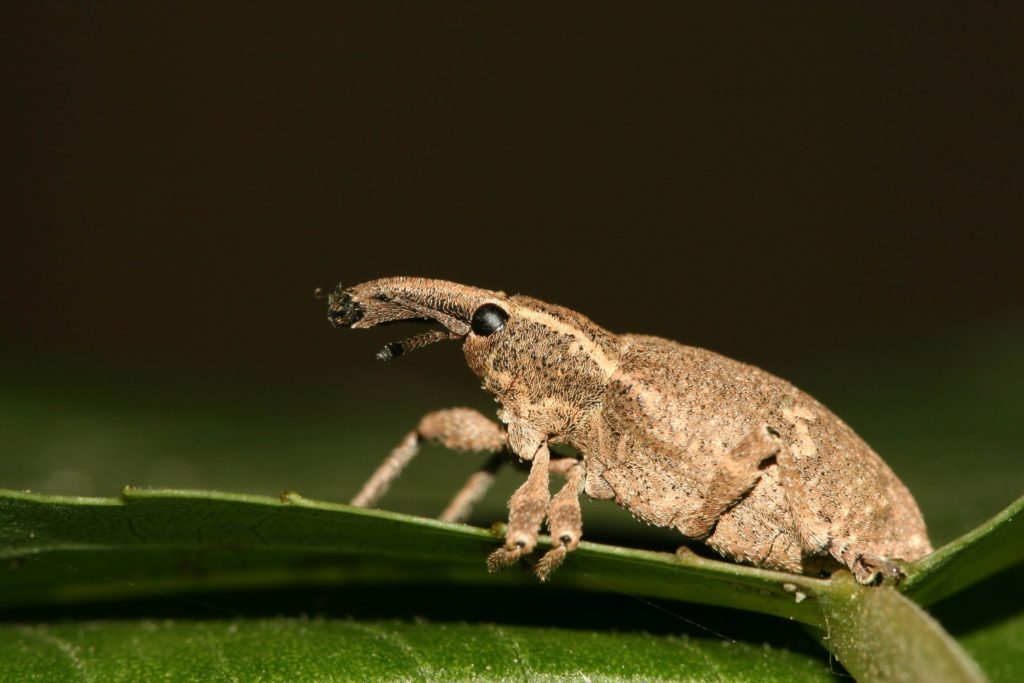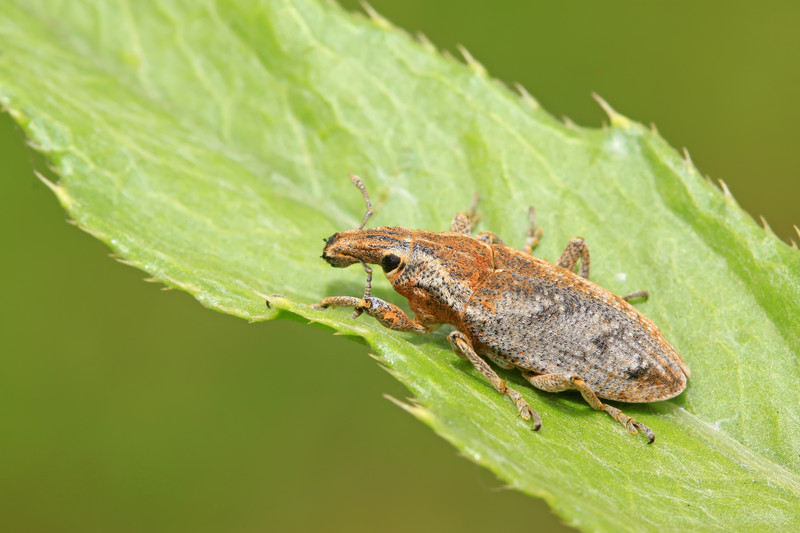Weevils are oval, brownish-gray or black, flightless, hard-shelled beetles about ⅓-inch long with a pronounced snout.
Weevil larvae are plump, white grubs up to ½-inch long with yellowish-brown heads.
Adult weevils chew on leaf edges leaving small scalloped bite marks. Larvae are soil-dwelling and feed on plant roots. Weevil-chewed leaves do little harm to plants, but larvae-chewed roots can cause plants to become stunted or fail.
Good Products for Pest and Disease Control at Amazon:
- Garden Safe Snail and Slug Bait
- Bonide Sulfur Fungicide
- Monterey BT Caterpillar Killer
- Neem Bliss 100-% Cold Pressed Neem Oil
- Safer Brand Insect Killing Soap
- PyGanic Botanical Insecticide

There are dozens of species of weevils. Several including the carrot weevil, bean weevil, and strawberry root weevil feed on vegetable and berry crops and also some fruit trees. (See more on weevil species below.)
Weevils overwinter as adults or grubs and emerge in spring. They feed for several weeks to build up their body reserves then lay eggs on the leaves of host plants. There are only female weevils–no males–so every weevil lays eggs. Eggs hatch in about 10 days and the larvae grubs immediately burrow into the roots of host plants to feed the rest of the year. They remain in the soil over the winter and resume feeding on roots in the spring. Overwintering grubs pupate in early spring
Adult weevils feed at night and hide in the soil during the day.
There are commonly one or more generations of weevils each year.
Scientific name: Carrot weevil (Listronotus oregonensis) attacks carrot, celery, dill, parsley, and parsnip plants by boring into the tops of the carrot roots or directly into the carrot heart; bean weevil (Acanthoscelides obtectus) feeds leaves and pods of beans, peas, and lentils; larvae bore into freshly harvested and stored beans; strawberry root weevil (Otiorhynchus ovatus) larvae bore into the crowns of strawberries and into the roots of raspberries, grapes, apples, peaches; adults feed on leaves and fruits.
Target plants
Weevils attack most garden vegetables as well as rhubarb, strawberries, blueberries, blackberries, raspberries, cranberries, apples, cherries, peaches, pears, and plums.
Feeding habits and damage
Weevil larvae and adults feed on the leaves and fruit of host plants. Larvae make zigzag paths into roots, fruits, or stems. The bean weevil does most of its damage to dried seeds.
Organic controls
Use juvenile parasitic nematodes to prevent larvae infestations. Use row cover barriers to keep adults out. Control serious infestations with pyrethrum, rotenone, or sabadilla.

Organic control calendar
Here is what you can do seasonally to control weevils:
- Before planting: Don’t grow the same host crop in the same place two years in a row, especially if there has been a serious weevil infestation the year before.
- At planting time: Dust diatomaceous earth around the base of plants to create a barrier; dust from the ground upwards covers all stems and leaves, especially the undersides of leaves. Place spun poly row covers over crops to exclude weevils; lay the cover directly on the plants and secure the cover with soil to exclude weevils. Apply a solution of insect parasitic nematodes.
- While crops develop: Inspect plants regularly. Knock weevils off of plants at night onto a piece of cardboard then destroy them. Lay boards in the garden and check for weevils hiding under them during the day. Place burlap around the base of plants; check in the morning for weevils hiding in the burlap after feeding at night; shake them into soapy water. Place traps with sticky glue near plants to capture weevils climbing plants. Treat serious infestations with pyrethrum or sabadilla sprayed weekly; make sure to cover all leaf surfaces. Introduce predatory nematodes to stop the reproduction of weevils.
- After harvest: Clean up and destroy dead plants of infested crops. Keep the garden free of weeds that can host weevils. Remove and destroy tree fruit that falls prematurely. Cultivate the garden thoroughly 6 to 8 inches deep to expose adult weevils and larvae to cold and birds.
Natural predators
Insect predators include spiders, ground beetles, and predatory nematodes. Animal predators include chickens, bluebirds, warblers, wrens, and other birds
Related articles:
Vegetable Garden Organic Pest Control
Vegetable Garden Diseases Problem Solver
Vegetable Garden Organic Weed Control
Garden Planning Books at Amazon:
- Vegetable Garden Almanac & Planner
- Kitchen Garden Grower’s Guide Vegetable Encyclopedia
- Vegetable Garden Grower’s Guide
- Tomato Grower’s Answer Book















